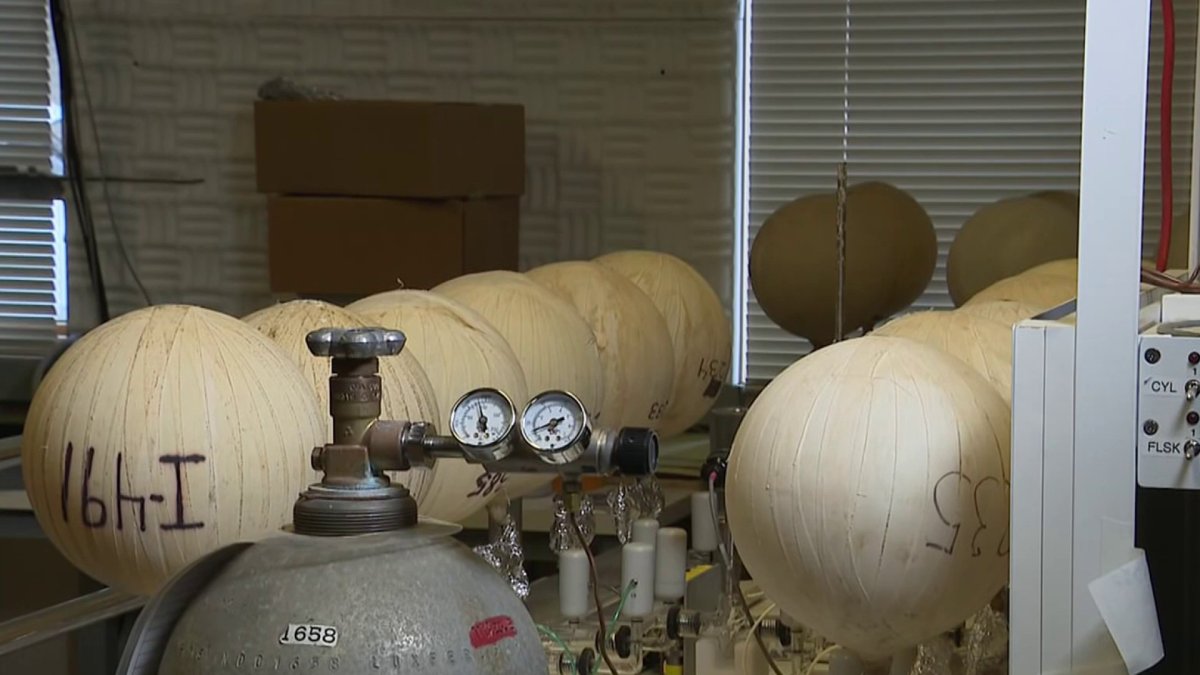Highest atmospheric CO2 level recorded in March, Scripps scientists say
Highest atmospheric CO2 level recorded in March, Scripps scientists say NBC San Diego


Record-breaking CO2 Levels: The Keeling Curve

Introduction:
The Keeling Curve, similar to the Dow Jones, measures the amount of carbon dioxide in the atmosphere. Scientists at Scripps Institution of Oceanography at the University of California, San Diego have been tracking these measurements from all over the world, and last month, they broke a record — but it’s not something to brag about.
The Keeling Curve and its Significance:
The Keeling Curve, named after Charles David Keeling who started taking measurements of CO2 at Mauna Loa Observatory in Hawaii in 1958, tracks the levels of carbon dioxide in the atmosphere. Over the past six decades, the levels have been steadily increasing, reaching a record high last month at 427 ppm. This rise is expected to continue throughout the year, exceeding peak levels. The Keeling Curve serves as a wake-up call for the planet as it undergoes significant changes.
Measuring CO2 Levels:
Glass flasks wrapped in tape are used to collect air samples from stations around the world, including Mauna Loa. These flasks are then shipped back to the lab in San Diego for analysis. The CO2 levels are determined by freezing out water vapor from the air and storing the CO2 in glass tubes for further analysis of isotopes. This allows scientists to identify if carbon dioxide comes from fossil fuels.
Factors Affecting CO2 Levels:
According to Ralph Keeling, a geochemistry professor at Scripps, CO2 levels can vary depending on the season and are influenced by factors such as El Nino. The Keeling Curve has shown a relentless rise, mainly due to the burning of fossil fuels and the release of excess carbon into the atmosphere.
Implications and Sustainable Development Goals:
The continuous rise in carbon dioxide levels is a cause for concern and emphasizes the need for action. To address this issue, it is crucial to focus on the Sustainable Development Goals (SDGs), particularly Goal 13: Climate Action. Slowing down the rise in CO2 levels requires reducing our reliance on fossil fuels and finding sustainable alternatives. It is essential to find ways to live while using less fossil fuel, promoting renewable energy sources, and adopting environmentally friendly practices.
SDGs, Targets, and Indicators
| SDGs | Targets | Indicators |
|---|---|---|
| SDG 13: Climate Action | 13.1: Strengthen resilience and adaptive capacity to climate-related hazards and natural disasters | – CO2 levels in the atmosphere – Rate of increase in CO2 levels |
| SDG 7: Affordable and Clean Energy | 7.2: Increase substantially the share of renewable energy in the global energy mix | – Rate of transition to renewable energy sources – Reduction in fossil fuel consumption |
| SDG 9: Industry, Innovation, and Infrastructure | 9.4: Upgrade infrastructure and retrofit industries to make them sustainable | – Investments in sustainable infrastructure – Adoption of sustainable practices in industries |
1. Which SDGs are addressed or connected to the issues highlighted in the article?
SDG 13: Climate Action
The article discusses the Keeling Curve, which measures the amount of carbon dioxide (CO2) in the atmosphere. The rising levels of CO2 are directly related to climate change and the need for climate action.
SDG 7: Affordable and Clean Energy
The article mentions the importance of reducing fossil fuel consumption in order to slow down the rise of CO2 levels. This aligns with SDG 7, which aims to increase the share of renewable energy in the global energy mix.
SDG 9: Industry, Innovation, and Infrastructure
The article emphasizes the need to upgrade infrastructure and retrofit industries to make them sustainable in order to reduce fossil fuel consumption. This aligns with SDG 9, which focuses on sustainable industrialization and innovation.
2. What specific targets under those SDGs can be identified based on the article’s content?
Target 13.1: Strengthen resilience and adaptive capacity to climate-related hazards and natural disasters
The article highlights the need to address the rising CO2 levels in order to mitigate climate change and its impacts. Strengthening resilience and adaptive capacity to climate-related hazards and natural disasters is crucial in achieving this target.
Target 7.2: Increase substantially the share of renewable energy in the global energy mix
The article emphasizes the importance of transitioning to renewable energy sources to reduce fossil fuel consumption and slow down the rise of CO2 levels. Increasing the share of renewable energy in the global energy mix is a specific target that can be identified.
Target 9.4: Upgrade infrastructure and retrofit industries to make them sustainable
The article mentions the need to upgrade infrastructure and retrofit industries to reduce fossil fuel consumption. This aligns with Target 9.4, which focuses on making industries sustainable through infrastructure upgrades and sustainable practices.
3. Are there any indicators mentioned or implied in the article that can be used to measure progress towards the identified targets?
The article mentions or implies several indicators that can be used to measure progress towards the identified targets:
– CO2 levels in the atmosphere: The Keeling Curve measures the amount of CO2 in the atmosphere, which can serve as an indicator of progress towards reducing CO2 emissions.
– Rate of increase in CO2 levels: Monitoring the rate at which CO2 levels are increasing can indicate the effectiveness of climate action measures.
– Rate of transition to renewable energy sources: Tracking the rate at which countries and industries transition to renewable energy sources can measure progress towards increasing the share of renewable energy in the global energy mix.
– Reduction in fossil fuel consumption: Monitoring the reduction in fossil fuel consumption can indicate progress towards reducing CO2 emissions and achieving sustainable energy goals.
– Investments in sustainable infrastructure: Tracking investments in sustainable infrastructure can measure progress towards upgrading infrastructure and retrofitting industries to make them sustainable.
– Adoption of sustainable practices in industries: Monitoring the adoption of sustainable practices in industries can indicate progress towards making industries more sustainable and reducing fossil fuel consumption.
4. Table: SDGs, Targets, and Indicators
| SDGs | Targets | Indicators |
|---|---|---|
| SDG 13: Climate Action | 13.1: Strengthen resilience and adaptive capacity to climate-related hazards and natural disasters | – CO2 levels in the atmosphere – Rate of increase in CO2 levels |
| SDG 7: Affordable and Clean Energy | 7.2: Increase substantially the share of renewable energy in the global energy mix | – Rate of transition to renewable energy sources – Reduction in fossil fuel consumption |
| SDG 9: Industry, Innovation, and Infrastructure | 9.4: Upgrade infrastructure and retrofit industries to make them sustainable | – Investments in sustainable infrastructure – Adoption of sustainable practices in industries |
Behold! This splendid article springs forth from the wellspring of knowledge, shaped by a wondrous proprietary AI technology that delved into a vast ocean of data, illuminating the path towards the Sustainable Development Goals. Remember that all rights are reserved by SDG Investors LLC, empowering us to champion progress together.
Source: nbcsandiego.com

Join us, as fellow seekers of change, on a transformative journey at https://sdgtalks.ai/welcome, where you can become a member and actively contribute to shaping a brighter future.







